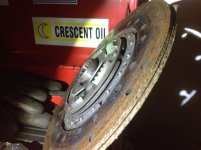SteveHall64Healey
Jedi Trainee
Offline
Gents, when I bought my BJ8 last year, the clutch was engaging quite high in the pedal, suggesting that a new clutch was going the be needed in the near future. The 75 year-old BMC mechanic who saftied the car last fall, drove the car into his shop and told me that the clutch was on its last legs, I might get another month or two out of it, and as the clutch is self-adjusting, the high clutch pedal is severe wear and not an adjustment issue. I have some of the service records for the car, but could not determine when/if the clutch had ever been replaced.
Yesterday, I removed the exiting clutch and it was virtually brand new. The thickness was 5/16"-same as the new one. The pressure plate and flywheels each had a depression of less then 1mm, so clearly the clutch was done recently.
The shop manual also states the clutch throw is self-adjusting, so I am trying to figure out why I get no engagement of the clutch until the last 1-2" of the pedal's throw. Has anyone encountered this issue before?
thanks,
steve
Yesterday, I removed the exiting clutch and it was virtually brand new. The thickness was 5/16"-same as the new one. The pressure plate and flywheels each had a depression of less then 1mm, so clearly the clutch was done recently.
The shop manual also states the clutch throw is self-adjusting, so I am trying to figure out why I get no engagement of the clutch until the last 1-2" of the pedal's throw. Has anyone encountered this issue before?
thanks,
steve

 Hi Guest!
Hi Guest!

 smilie in place of the real @
smilie in place of the real @
 Pretty Please - add it to our Events forum(s) and add to the calendar! >>
Pretty Please - add it to our Events forum(s) and add to the calendar! >> 

